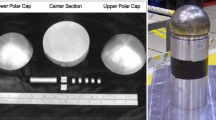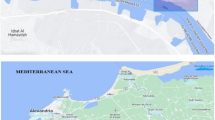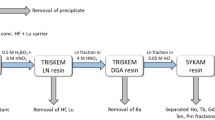Abstract
FOLLOWING the unsuccessful search for fission of lead and bismuth by a chemical method1, an attempt was made using track counts in irradiated ‘loaded’ plates. It is possible through desensitization (bathing for 5 min. in 1 per cent chromic acid, rinsing with water and drying) before irradiation to suppress fogging by γ-rays and the proton recoil tracks due to the fast neutrons2. Therefore the plates can be exposed to very high doses of fast neutrons. α-Ray tracks from uranium are weakened in the desensitized plates, but fission tracks from uranium still stand out boldly, and are easily identified and counted under a microscope (× 1,500).
This is a preview of subscription content, access via your institution
Access options
Subscribe to this journal
Receive 51 print issues and online access
$199.00 per year
only $3.90 per issue
Buy this article
- Purchase on Springer Link
- Instant access to full article PDF
Prices may be subject to local taxes which are calculated during checkout
Similar content being viewed by others
References
See preceding communication.
Cf. Green and Livesey, Nature, 158, 272 (1946).
Cf. Powell, Occhialini, Livesey and Chilton, J. Sci. Instr., 23, 102 (1946).
Author information
Authors and Affiliations
Rights and permissions
About this article
Cite this article
BRODA, E. Determination of the Upper Limits of the Fission Cross-sections of Lead and Bismuth for Li-D Neutrons by a Track Count Method. Nature 158, 872–873 (1946). https://doi.org/10.1038/158872a0
Issue Date:
DOI: https://doi.org/10.1038/158872a0
This article is cited by
Comments
By submitting a comment you agree to abide by our Terms and Community Guidelines. If you find something abusive or that does not comply with our terms or guidelines please flag it as inappropriate.



